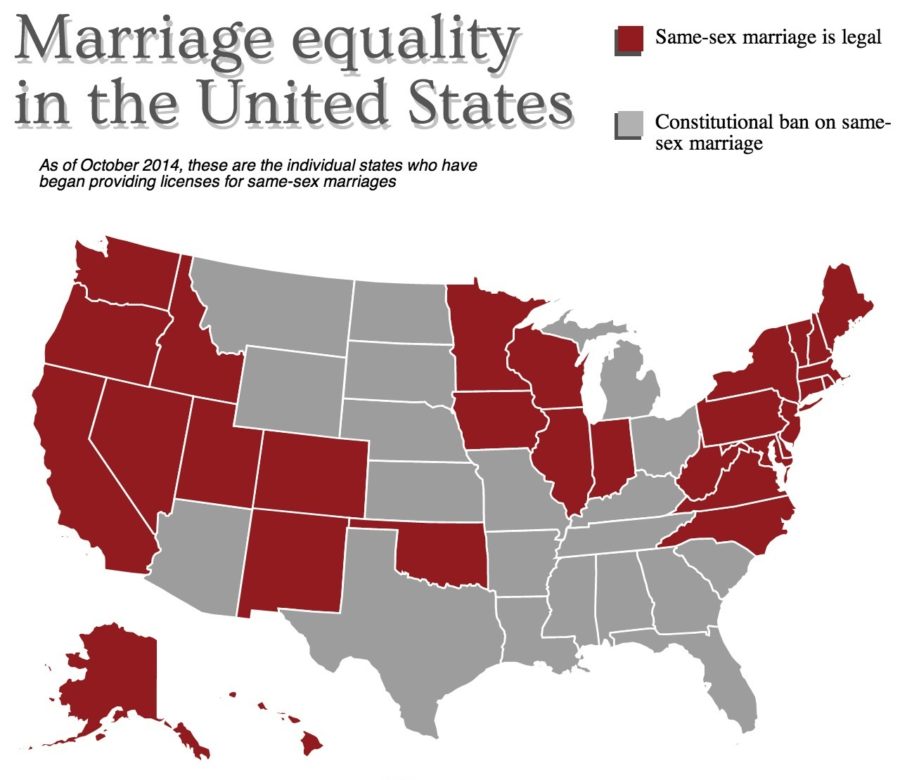LGBT laws differ from state to state
Richard Martinez/Iowa State Daily
INFOGRAPHIC: Same-sex marriage in the U.S.
October 16, 2014
Same sex marriage is a popular topic when it comes to legal rights of LGBTQA people, but advocates don’t want the push to stop there.
There are 29 states which don’t mention sexual orientation in their non-discrimination laws and 32 that do not include gender identity, according to the Human Rights Campaign.
The U.S Supreme Court denied the appeal of rulings by the U.S. 4th, 10th and 7th District Courts which ruled same sex marriage bans unconstitutional in Virginia, Wisconsin, Indiana, Oklahoma and Utah. The Supreme Court’s decision to deny the appeal has made same sex marriage legal in 30 states.
The Iowa Civil Rights Act prohibits discrimination based on gender identity and sexual orientation, but if someone gets a job out of the state of Iowa they might not have those protections under the law.
Iowa is one of 18 states — plus the District of Columbia — that has sexual orientation and gender identity listed in its anti-discrimination laws, according to the American Civil Liberties Union.
“It is so important to me that I can be in a place where I can be fully authentic,” said Nicci Port, an administrative specialist in the human sciences department. “I would not even consider looking at a state that didn’t have those types of things in place.”
Adam Guenther, president of the LGBT Ally Alliance and senior in animal science, said it is nerve-wracking not knowing if he will be able to be open as a member of the LGBTQA community at job or internship to which he is applying.
He also said he worries about listing certain organizations on his resume.
Iowa also has anti-bullying laws that include sexual orientation and gender identity. LGBTQA youth are at a higher risk of being bullied according to the CDC and stopbullying.gov, a website that is run by the Department of Health and Human Services.
Guenther said he thinks having bullying protections for LGBTQA youth especially in the K-12 level is especially important because it helps remove barriers to education and comes at a time when people are developing themselves.
“I always think it’s good to get a little bit specific with things. I mean not that you wouldn’t want all the bullying to be eradicated, but I think it’s good to pull out those specific classes actually because I don’t think everybody interprets the laws the same,” Port said.
Port said she thinks people may not always be thinking about sexual orientation or gender identity when they are trying to prevent bullying.
Sexual orientation and gender preference is not mentioned in the United States federal hate crime law.
“Transgender people make up 1 to 1.5 percent of the world’s population but about 400 times more likely to be assaulted or murdered than the rest of the population. These crimes are more likely to be violent, and are often meant to intimidate the entire community,” according to transviolencetracker.org, an organization dedicated to showing the amount of violence transgender people face.
Trans Violence tracker published a report of 102 reported cases of transgender violence from January 1 to April 30 of 2014. There are 11 states that have gender identity listed in their hate crime laws.
“I don’t know why more states don’t have the gender expression included in their laws because it’s always been an issue where people are bullied or hate crimes are perpetrated against them because they present themselves in ways that people don’t think they should,” Port said.
Guenther said he believes there should be added penalties for people whose crimes target certain groups and that sexual orientation and gender identity should be included with religion and race.
Port said she thinks sexual orientation has become part of the collective consciousness as a nation, and thinks gender identity is soon to follow.







